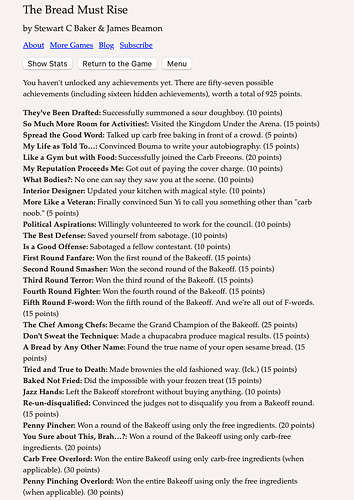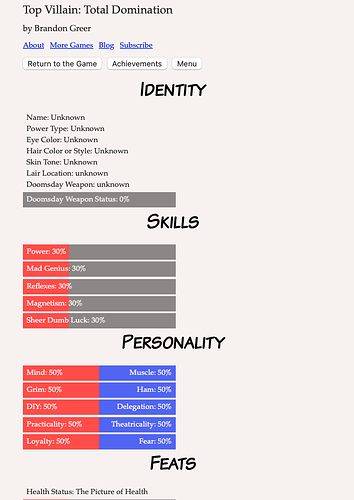This game, a feature of every single convention since the first, was the brainchild of Jim O`Keeffe. The idea is that contestants are given 20 minutes playing time at a specially-written text adventure, with the object of scoring as many points as possible. The first game used for Megapoints was a specially adapted version of part 1 of my own text adventure, “Run, Bronwynn, Run!”, a game which was eventually finished and released a few years later! This game was written using “P.A.W.”, the Professional Adventure Writer utility. Winner of the first-ever Megapoints was a chap called Jack Higham, who won mainly because of his incredibly fast typing - his fingers flew over the keyboard so fast we swear we saw smoke.
One fascinating aspect of the Megapoints Game for me, as the author of the text adventure being used, was watching all those different people playing my game in front of me. I couldn’t believe the things they were inputting and was constantly taking notes - it was like a great big play testing session. We thought we’d eradicated all the bugs in the game, but a few more were found (fortunately they didn’t prevent anyone from continuing), as well as a few spelling and grammatical errors.
Various text adventure authors have contributed games for the Megapoints Competition over the years. At the third convention, young Scott Denyer, proprietor of “Delbert the Hamster Software”, wrote a game called “Exploits in a Wheelie-Bin” for the Megapoints. As I had provided the games for the first two years, it was a pleasant change to actually be competing in the competition, instead of running it. When it came to my turn we had, as usual, three Spectrums in use, but I didn’t notice that I was asked to sit at one particular machine, rather than choosing one of the three at random, as everyone else had. Once I started, I found it incredibly hard to score points, even though I seemed to be solving the puzzles in the adventure. Whenever I did manage to score any points, they were swiftly taken away a few moves later! Total score after 20 minutes: 0 points! Everyone else managed to score at least a few points, and I put my failure to score any points down to the fact that I was much better at writing games than I was actually playing them.
Afterwards, when I was discussing the game with some other competitors who had already had their goes (we were under strict instructions not to talk to anyone who hadn’t had their turn, of course), they were mentioning things in the game that I had not seen… and I began to smell a rat! Sure enough, when the winning trio was announced, Scott admitted that I had been the victim of a wind-up and the particular version of the game I’d been playing had been doctored so that any points I scored were deducted a few moves later! It turned out that this plot was hatched at a meeting of The Hamilton Halls Gang in London which I had been unable to attend.
This caused much merriment amongst the people at the convention, and I was rather embarrassed, to say the least, although I did take it all in good heart. I was, however, determined to get my own back, but the next year all but one of the co-conspirators were, for various reasons, unable to attend the convention. The only one who was there was Martin Freemantle, but as luck would have it, he was doing the Megapoints game that year. I suddenly had a brainwave - if they made it so I couldn’t score any points in the last Megapoints competition, then I would score MAXIMUM points at the next one! I knew that Sharon Harwood (another of the conspirators not at the convention) was play testing the adventure, so I phoned and told her what I was plotting and she readily agreed to send me a copy of the final version which would be used in the actual Megapoints Competition.
I played that game to death during the weeks before the convention, learning all the point-scoring inputs so that eventually I was able play through the whole game, scoring the maximum number of points (250) without referring to a solution. On the day of the convention, all went according to plan, and I played the game, “Curse of the Serpent’s Eye”, all the way through, although I did make one mistake near the end and missed a few points. Jenny Perry was supervising the running of the game when I took my turn, and when she saw how many points I’d scored after 15 minutes play (it was over 200), she rushed over to Martin and told him. He was busy attending to customers who were buying games from his “DreamWorld Adventures” table and I remember that it didn’t seem to register with him that I’d scored so many points.
Afterwards, when word went round of the incredible score I’d achieved, people asked me how I’d managed it. I told them - quite truthfully in some respects - that solving a certain puzzle, involving a letterbox I seem to remember, opened up the whole adventure and I was just plain lucky! When it came to awarding the certificates (I had to let a couple of people in on the secret so that a certificate wasn’t completed with my name on it) I stepped up and, instead of taking the winners certificate and retiring gracefully, I asked to say a few words. I told the conventioneers about the previous year’s wind-up and revealed, to howls of laughter, how I’d been able to get my own back on the only conspirator present. As I said all this, Martin just sat with his head in his hands, absolutely squirming with embarrassment. Oh sweet revenge! Afterwards, he phoned Sharon and said a few choice words to her, most of which are unrepeatable here. The 1st Prize Certificate did, of course, go to the person who came second, but who really came first… if you see what I mean?

